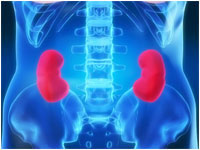 Tenofovir
(Viread, also in the Truvada
and Atripla
coformulations) is highly effective in treating both hepatitis
B virus (HBV) and HIV, but it can cause kidney impairment
in susceptible individuals.
Tenofovir
(Viread, also in the Truvada
and Atripla
coformulations) is highly effective in treating both hepatitis
B virus (HBV) and HIV, but it can cause kidney impairment
in susceptible individuals.
As
reported in a poster at the European Association for the Study
of the Liver's International Liver Congress (EASL
2011) this month in Berlin, French researchers compared
changes in glomerular filtration rate (GFR) -- a laboratory
measure of kidney function -- in HIV monoinfected, HBV monoinfected,
and HIV/HBV coinfected patients treated with tenofovir.
This
retrospective analysis included 194 HIV positive patients receiving
first-line antiretroviral therapy, 50 people with hepatitis
B alone, and 85 with HIV/HBV coinfection. All participants had
used tenofovir for more than 1 year. As a group, the coinfected
patients had taken tenofovir significantly longer than those
with HIV or HBV alone (3.9 years vs 2.4 years, respectively).
More
than 70% of study participants were men and about one-third
were of African descent (a group at higher risk for kidney diseases).
People with HBV were on average older, less likely to be African,
and had lower baseline GFR. Patients with decompensated cirrhosis,
liver cancer, pre-existing kidney insufficiency, and liver transplant
recipients were excluded.
Results
 |
Over
a median follow-up period of 2.7 years, the median GFR decrease
according to the MDRD equation was -4.9 mL/min. |
 |
In
a multivariate analysis, significant predictors of GFR decrease
in the study population as a whole were: |
| |
 |
Older
age (P = 0.0002); |
 |
African
origin (P < 0.0001); |
 |
Poorer
GFR at baseline (P < 0.0001); |
 |
Longer
duration of tenofovir use (P = 0.02). |
|
 |
In
contrast, arterial hypertension (high blood pressure), diabetes,
and type of infection (HIV, HBV, or HIV/HBV) were not independent
risk factors. |
 |
Among
HIV monoinfected and HIV/HBV coinfected participants, the
following factors remained significantly associated with
GFR decline: |
| |
 |
Older
age (P < 0.0001); |
 |
African
origin (P = 0.0004); |
 |
Poorer
baseline GFR (P < 0.0001); |
 |
Longer tenofovir duration (P = 0.007). |
|
 |
Other variables, including HIV transmission risk factor,
CDC HIV/AIDS stage, CD4 T-cell count, and HIV viral load
were not significant risk factors. |
 |
Among
people with HBV alone or HIV/HBV coinfection, significant
predictors were: |
| |
 |
Older
age (P = 0.03); |
 |
African
origin (P = 0.004); |
 |
Poorer
baseline GFR (P < 0.0001); |
 |
HBV
viral load > 2000 IU/mL (P = 0.04). |
|
 |
Other
variables including HBV transmission risk factor and liver
fibrosis stage were not independent predictors. |
Based
on these findings, the researchers concluded, "GFR decline
under tenofovir therapy appears mainly associated with older
age, non-African origin, higher baseline GFR and longer tenofovir
duration. The effect of baseline HBV DNA deserves further study."
Investigator affiliations: Hospices Civils de Lyon, Lyon,
France; INSERM U871, Université Lyon 1, Lyon, France.
4/19/11
Reference
L Cotte, M-A Le Pogam, J-B Okon, et al. Evolution of glomerular
filtration rate in HIV-infected, HIV-HBV coinfected and HBV-infected
patients receiving tenofovir. 46th Annual Meeting of the European
Association for the Study of the Liver (EASL 2011). Berlin.
March 30-April 3. Abstract
587.
